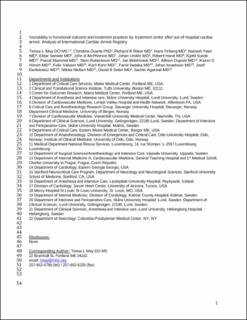Variability in functional outcome and treatment practices by treatment center after out-of-hospital cardiac arrest: analysis of International Cardiac Arrest Registry
May, Teresa L.; Lary, Christine W.; Riker, Richard R.; Friberg, Hans; Patel, Nainesh; Søreide, Eldar; McPherson, John A.; Undén, Johan; Hand, Robert; Sunde, Kjetil; Stammet, Pascal; Rubertsson, Stein; Belohlvaek, Jan; Dupont, Allison; Hirsch, Karen G.; Valsson, Felix; Kern, Karl; Sadaka, Farid; Israelsson, Johan; Dankiewicz, Josef; Nielsen, Niklas; Seder, David B.; Agarwal, Sachin
Journal article, Peer reviewed
Accepted version
Permanent lenke
https://hdl.handle.net/11250/2738645Utgivelsesdato
2019Metadata
Vis full innførselSamlinger
- Department of Clinical Medicine [2066]
- Registrations from Cristin [9791]
Sammendrag
Purpose
Functional outcomes vary between centers after out-of-hospital cardiac arrest (OHCA) and are partially explained by pre-existing health status and arrest characteristics, while the effects of in-hospital treatments on functional outcome are less understood. We examined variation in functional outcomes by center after adjusting for patient- and arrest-specific characteristics and evaluated how in-hospital management differs between high- and low-performing centers.
Methods
Analysis of observational registry data within the International Cardiac Arrest Registry was used to perform a hierarchical model of center-specific risk standardized rates for good outcome, adjusted for demographics, pre-existing functional status, and arrest-related factors with treatment center as a random effect variable. We described the variability in treatments and diagnostic tests that may influence outcome at centers with adjusted rates significantly above and below registry average.
Results
A total of 3855 patients were admitted to an ICU following cardiac arrest with return of spontaneous circulation. The overall prevalence of good outcome was 11–63% among centers. After adjustment, center-specific risk standardized rates for good functional outcome ranged from 0.47 (0.37–0.58) to 0.20 (0.12–0.26). High-performing centers had faster time to goal temperature, were more likely to have goal temperature of 33 °C, more likely to perform unconscious cardiac catheterization and percutaneous coronary intervention, and had differing prognostication practices than low-performing centers.
Conclusions
Center-specific differences in outcomes after OHCA after adjusting for patient-specific factors exist. This variation could partially be explained by in-hospital management differences. Future research should address the contribution of these factors to the differences in outcomes after resuscitation.
